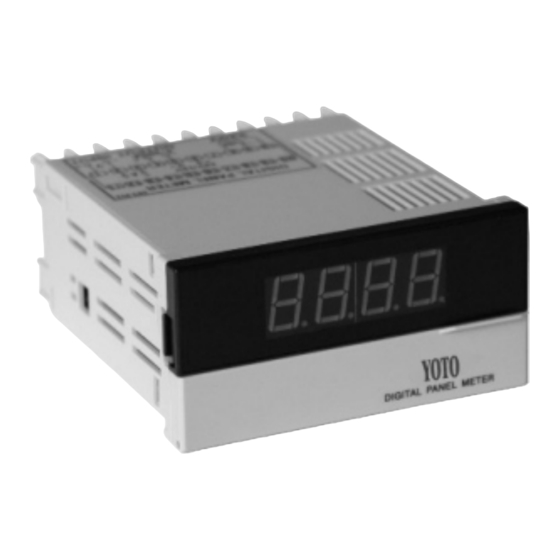
Table of Contents
Advertisement
Quick Links
■
Applications
Suitable for all kinds of sensors with linear output and other testing equipment.
This instrument can measure any range of current or voltage signal input.
It can be with 2-wire transmitters, pressure sensors, 4-wire weight sensors and so on.
Thanks a lot for selecting YOTO products!
For your safe, please carefully read this manual and fully understand its contents before operating this instrument. If you have
problems, please contact our sales or distributors whom you buy from. This manual is subject to change without prior notice.
▲
SAFETY CAUTIONS:
※
Make sure the power is at OFF status before connecting the wires to avoid electric shock and strictly follow the
connection diagram given out by the factory which is stuck on the product.
※
Make sure the power OFF when cleaning the product.
※
Working beyond the stated power supply (90 - 260V AC) is prohibited so as to avoid damage to the product
or cause fire. The use life of the output relay is quite different according to its capacity and conditions.
※
Make sure the output relay is used at the rate load and electrical life, if the contact of the output relay works
against the electrical life, it may melt or burned or even cause fire.
※
Do not wire when the power is on. Do not connect the unused terminals. Do not disassemble, repair or modify
the instrument. This may cause electrical shock, fire or malfunction.
1. Ordering Code
DP
SVA
※
Example: DP3-SVA1B means that it is a DP3-SVA Series, 3 1/2 digit LED display sensor meter,
with no analogue output, auxiliary power 24V DC.
2. Technical Specification
Measured function
Input signal
Accuracy
A/D converter
Sampling rate
Full scale
Display mode
Load
Ambient temperature 0℃ ~ 50℃
Power supply
Dimension (mm)
Weight (appr)
Dielectric strength
Insulation resistance 500V DC/ 100MΩ
DP-SVA Series Digital Sensor Indicator
Instruction Manual
■
FEATURES:
※
This instrument is widely applied to all kinds of sensors with
linear output and other testing equipments to measure pressure,
weight, temperature, humidity, etc.
※
With decimal point setting, rate, range and zero point adjustment.
※
With analogue output 4 - 20mA DC
※
With auxiliary power supply: 12V or 24V
※
Power supply: 220V AC
A: Auxiliary power 12V DC
Analogue output
DP3-SVA: DP3-SVA Series 3 1/2 digit sensor meter
DP4-SVA: DP4-SVA Series 4 1/2 digit sensor meter
Equipped with all kinds of sensors
Current: 4 ~ 20mA, 0 ~ 10mA, Voltage: 0 ~ 10V, 0 ~ 5V, 0 ~ 1V, 0 ~ 200mV, 0 ~ 20mV
± 0.5%FS ± 2 digit
Dual integral
2.5 times/second
DP3: 1999(decimal point can be set freely)
Red LED display (high: 14.2mm)
≤600Ω
AC 110V/ 220V, 50/ 60Hz
48H X 96W X 100L
450g
1500V AC/ 1min
B: Auxiliary power 24V DC
1: No analogue output
DP4: 19999(decimal point can be set freely)
2: With 4 ~ 20mA analogue output
P1
Advertisement
Table of Contents

Summary of Contents for Yoto DP-SVA Series
- Page 1 It can be with 2-wire transmitters, pressure sensors, 4-wire weight sensors and so on. Thanks a lot for selecting YOTO products! For your safe, please carefully read this manual and fully understand its contents before operating this instrument. If you have problems, please contact our sales or distributors whom you buy from.
- Page 2 DP-SVA Series Digital Sensor Indicator 3. Function setting While setting the range and the decimal point, be sure to pull out the internal printed circuit board, as the follow figure hows: Figure 1 Figure 1 The pin head of decimal point setting The pin head of range setting 1).
- Page 3 DP-SVA Series Digital Sensor Indicator ※ Application example: connect with pressure transmitter Figure 1 Pressure transmitter: output signal in: 4 ~ 20mA, 2-wire Use with 2-wire pressure transmitter/ sensor. The instrument can supply DC 24V auxiliary power, and the sensor output is 4 ~ 20mA. Software select input signal mA. Please refer to above figure 1.
Need help?
Do you have a question about the DP-SVA Series and is the answer not in the manual?
Questions and answers